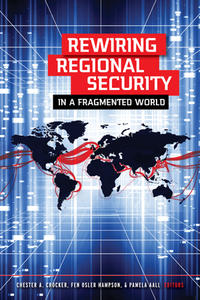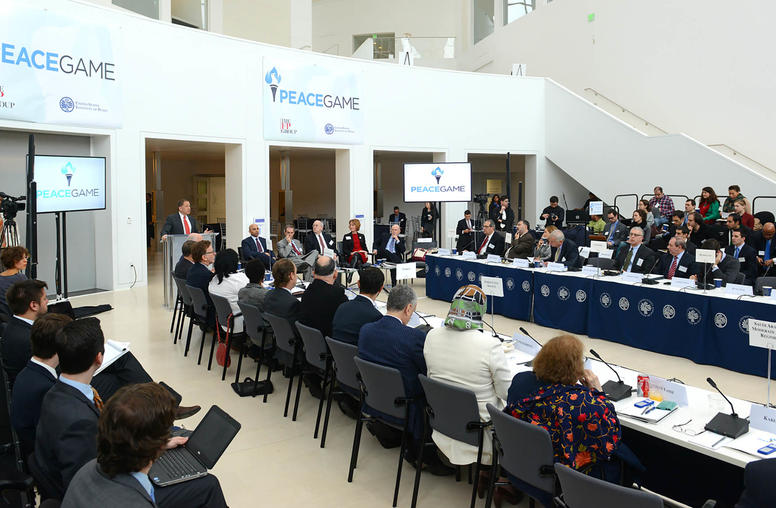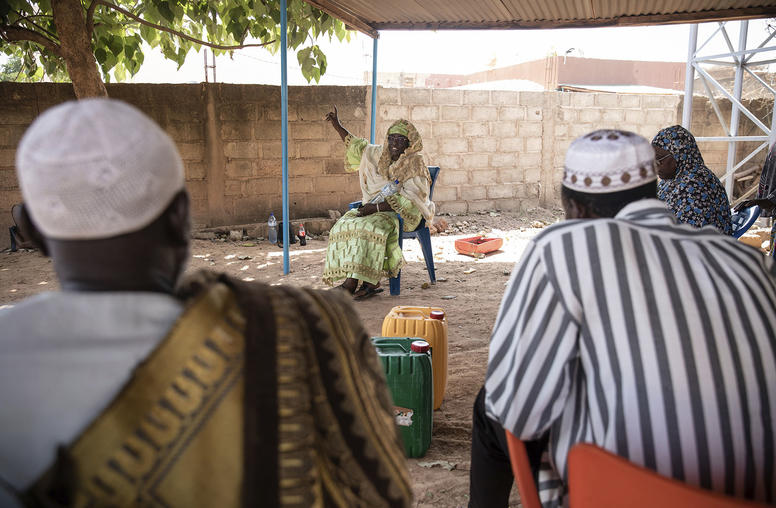Chester Crocker on the State of Peacebuilding
Chester A. Crocker, long-serving member of USIP's Board of Directors, discusses the future of peacebuilding, the impacts of cuts to national security budgets, his contributions as a board member and chairman, USIP's unique national security functions and Academy, and more.
Chester Crocker, professor of strategic studies at Georgetown University’s Walsh School of Foreign Service and former assistant secretary of State for African Affairs, steps down this year from the U.S. Institute of Peace’s board of directors after serving since 1991 and as board chairman from 1992 to 2004.
As part of a series of conversations on global change, peacebuilding, and USIP, he discusses how the field of peacebuilding has evolved since joining the Institute, where the field is going, and whether the world is any less chaotic now.
- With so many active conflicts, and amid intense international financial chaos and stress, where is the business of peacebuilding going?
- How does cutting the national security affairs budget impact us in the long-term? And how does that affect most Americans?
- You served as USIP board chairman from 1992 to 2004, and a board member since then. In which areas do you feel you’ve helped shape the Institute of Peace – and the field of peacebuilding itself?
- How does USIP perform national security functions in ways that other federal agencies cannot? Why are we unique?
- What are your hopes for USIP’s Academy?
- Is peacebuilding becoming a professional field in its own right?
- You’ve written extensively on global conflict in “Managing Global Chaos,” “Leashing the Dogs of War” and “Herding Cats.” So, here we are in 2011. Is the world less chaotic?
With so many active conflicts, and amid intense international financial chaos and stress, where is the business of peacebuilding going?
The field has gone through different phases. During the Cold War, it was barely recognizable as a field. After the collapse of the Soviet Union, there was a brief hey-day when everyone was doing peacebuilding – and that’s when you saw the field ramp up.
During the 1990s, the U.S. became a third party in a lot of conflicts – in the Balkans, places in Africa, like in Somalia, Rwanda, and in Southeast Asia. We were helping to end fighting in these areas; it was considered a central part of our foreign policy.
Since then, two major things happened to change the dynamics of the field: Some United Nations operations did not go very well and then, second, we had 9/11. At that point, we went back to fighting wars in which we were a direct party, rather than the third party.
Up through 2006, conflict management has been deemphasized but then we realized we couldn’t solve problems through conflict, but needed to return to peacemaking and peacebuilding.
What we’re seeing at the moment is the conflict management phase of how to make the war-to-peace transition work better, how to stand up weak states and how to rebuild accountable governments after conflict. That’s where everyone’s head is at the moment. That’s what we’re seeing in Afghanistan, for example, and that work is very messy.
My hunch is that we’re coming to the end of that phase and we need to put more emphasis on conflict prevention, mediation and crisis diplomacy. We can’t just deal with the world in the post-conflict phase – it is too expensive and there’s a limited appetite in our system for it.
If I look down the road of the conflict management field, we need to remember it’s not just about the post-conflict phase. We are not a colonial power. There’s a big focus on post-conflict reconstruction and stabilization – which is understandable given that we have a deep commitment to several wars.
But that’s not the future – there’s no appetite for it in democratic countries. We need to invest in prevention, mediation and crisis diplomacy before countries blow up – and to prevent us from getting to that point.
How does cutting the national security affairs budget impact us in the long-term? And how does that affect most Americans?
When countries fall apart – such as Somalia -- Americans will be the first to step up with humanitarain assistance. That costs taxpayer dollars.
So, it makes sense to avoid having countries fall apart and to engage in conflict prevention.
These cuts also hurt the United States because military engagement -- while sometimes unavoidable -- is by far the most expensive and most blunt instrument.
We need civilian instruments to make intervention and engagement possible before a country collapses or before you have people demanding regime change. It saves money ultimately. And a small organization like USIP is a rounding error for the budget people.
You served as USIP board chairman from 1992 to 2004, and a board member since then. In which areas do you feel you’ve helped shape the Institute of Peace – and the field of peacebuilding itself?
It’s tricky to describe what your own contribution has been. I’ve worked to underscore the correlation between practice and research. We have to be very close to the applied research – and the best practices – that is going on.
We‘ve seeded and developed this field for the past 20 years – and it’s important to continue to build that educational base across the U.S. and the world . That in effect builds the capacity of other institutions and nations to do conflict management themselves.
We are an applied research laboratory. We need the connection to the research world but we also need to be continuously rolling out and transmitting this knowledge to those in the field, and then learning from their experiences and taking those lessons back to the research lab.
I’ve also tried to strengthen the bipartisan environment and create a board that will give our staff and leadership the space to grow and build. You can call it providing air cover.
I’d also mention that we did a lot of field-defining publishing on conflict management -- the series of text books I’ve worked on is an example of that, such as “Managing Global Chaos: Sources of and Responses to International Conflict,” “Herding Cats: Multiparty Mediation in a Complex World,” “Leashing the Dogs of War: Conflict Management in a Divided World,” and “Rewiring Regional Security in a Fragmented World.” USIP’s “Cross Cultural Negotiation” series is another example of this field-defining work.
The books I’ve done with Pamela Aall and Fen O. Hampson have pulled together the different parts of the conflict management constituency that includes behavioral sciences, security studies and peace studies, negotiation and mediation, peacekeeping and military intervention. It’s a diverse field. We’ve brought people together and connected the dots in these publications.
One of the things we also worked hard to do was to develop and deploy an operational capacity to have people on the ground in conflict zones -- starting with the Balkans. We’ve done this without losing sight of our roots as an educational and research institute dedicated to testing ideas. We became more operational, but without losing the applied research side. That side supports the operational capacity.
How does USIP perform national security functions in ways that other federal agencies cannot? Why are we unique?
First, we are bipartisan by statute. We are the go-to place for bipartisan research and policy, and for policy discussion. We have a proven record of this and working on difficult issues. Our board is bipartisan. Congress and others look at us as a place where you can avoid the poisonous flavor of partisan politics. You wouldn’t find that in a U.S. department because it’s working for an administration.
Second, we have standing with nonofficial actors -- and that includes parties that are actually in conflict zones. We can convene anybody – international civil servants, those working for regional associations, like the AU and EU. We have earned that convening legitimacy.
Third, our skill set doesn’t exist in any other federal agency. There is no other place where people are both experienced practitioners and researchers on conflict management.
What are your hopes for USIP’s Academy?
The Academy is the future because of its core function. It’s a transmission belt for the Institute’s applied research. It’s where the applied thinking and lessons learned are rolled out to mid-career professionals working in official jobs and for nongovernmental organizations. It is the sharing of knowledge in order to empower more people in the area of conflict management. I don’t think we’re ever going to become a big organization where its staff is doing all the operational work. The Academy is where we teach people how to do that work. It’s the way you scale-up the field. I would add that it’s not just scaling up to do post-conflict reconstruction and stabilization, but it’s also about addressing gender and conflict issues, the challenge of extractive industries, or conflict and radical Islam.
Is peacebuilding becoming a professional field in its own right?
I don’t think it should become stove-piped into a separate professional field. The field is becoming more mainstream, but linked to foreign policy, and woven into diplomacy and the practice of organizations, like humanitarian and human rights organizations, and regional bodies. It’s more of a set of skills and types of wisdom that need to be brought into the existing institutions.
You’ve written extensively on global conflict in “Managing Global Chaos,” “Leashing the Dogs of War” and “Herding Cats.” So, here we are in 2011. Is the world less chaotic?
It’s a different kind of chaos. We used that title in the mid-1990s when we saw lots of ethnic conflict and countries working out of their Cold War alliances and, in some cases, falling apart. In the world today, there are other sources of chaos.
Governments that have done conflict management are stretched thin in terms of their budgets and domestic support. Like the U.S., UK, Canada, Norway. We are seeing more regional organizations assert themselves as the logical first port of call. For example, in Libya, the decision for NATO to act, the United Nations moved only because the Arab League issued a call for that to happen. You have more international actors. And, you have many more unofficial international actors, as many of whom are creating problems as there are trying to resolve them.
It’s a more crowded field. There’s no gatekeeper. There’s a kind of spontaneity to it and a lack of hierarchy. Which makes it more chaotic – and sometimes you don’t know who is in charge. Sometimes that’s because the answer is no one is.
Explore Further
- Global Change, Peacebuilding and USIP
USIP leaders explain the effect that events around the world and here at home will have on the U.S., and the contributions the Institute can and does make during a time of tremendous challenge – and opportunity. - Learn more about Chet Crocker
- The Arab Spring News Feature
- Waging Battles that Make War




